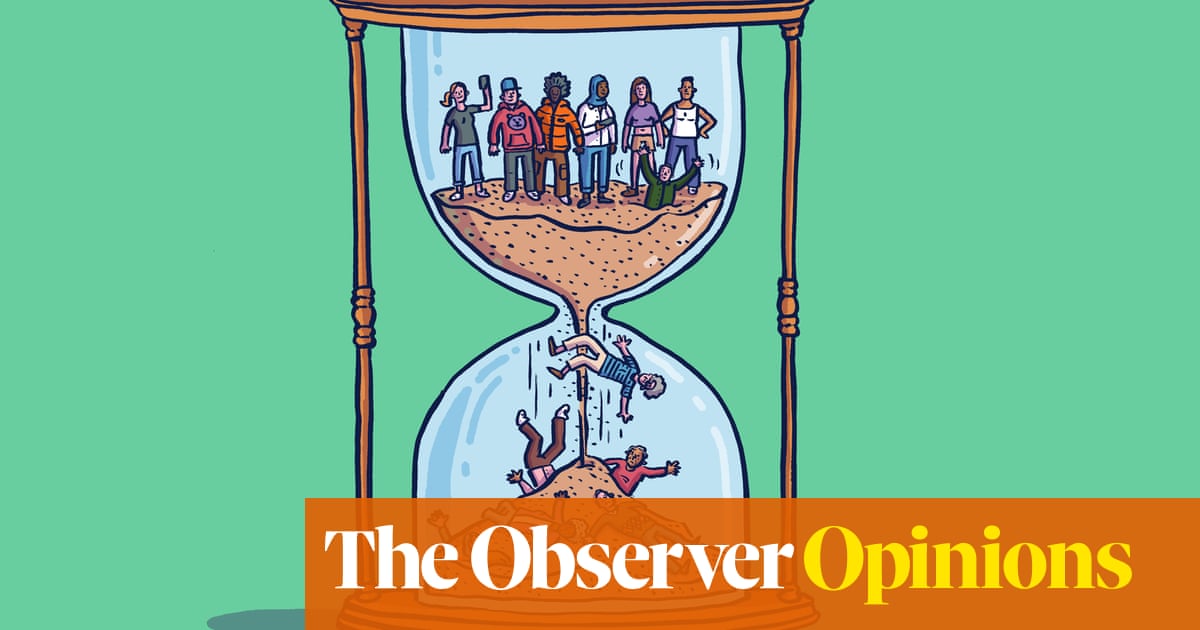FOGO, our fear of growing old, is sweeping the land. Just look at Trinny Woodall | Martha Gill
FOGO, our fear of growing old, is sweeping the land. Just look at Trinny Woodall The Guardian


Ageism: A Prejudice Against Ourselves

Ageism is perhaps the most paradoxical prejudice: we are, barring accident, discriminating against ourselves. Members of the persecuting in-group are through the course of their lives gently conveyor-belted into the persecuted out-group, which is, when you think about it, a very strange state of affairs. If the rich inevitably became poor at a certain life stage, you might expect society to fill with vigorous socialists. But ageism persists. Why?
The best explanation perhaps is that it comes down to a sort of mass delusion on the part of the young. John Steinbeck wrote of America’s “temporarily embarrassed millionaires”, the poor who resist measures to hand them money because they believe one day they will be rich. When it comes to ageing, the fallacy runs in the other direction: the lucky believe their luck will never end. “One day that will be us struggling with newfangled technology,” the young say, as a joke, not really thinking it will be. “I’ll need that Zimmer frame one day,” they say, thinking they won’t.
The Sustainable Development Goals and Ageism
- Goal 1: No Poverty
- Goal 3: Good Health and Well-being
- Goal 8: Decent Work and Economic Growth
- Goal 10: Reduced Inequalities
- Goal 11: Sustainable Cities and Communities
The old are not discriminated against in every respect. In Britain, we hand over an increasing proportion of our resources to support them. A row over whether to keep the triple lock on state pensions rages in Westminster but doesn’t inspire much fury beyond it. Young people largely support the triple lock; the state pension is, after all, what keeps some of their grandparents out of poverty. (The yawning inequality between boomers and younger generations mainly concerns housing wealth, not the state pension.) And young people may reasonably fear that tampering with the state pension now could set an unfortunate precedent for their own retirement. The triple lock will finally be broken, the joke goes, when the first millennial reaches pension age.
This makes psychological sense. What’s odd is that, while we support the old financially, we continue to discriminate against them in other ways. It’s a benevolent prejudice, of sorts – we view the old as deserving of protection, but not respect. Some of these ways are “merely” social. Reports find older people to be widely mocked and patronised by the rest of society. The young tend to view them as rather homogenous – a grey blur rather than a group of individual personalities, even though they must recognise, even from their own limited experience, that we tend to grow less similar as we grow older.
Ageism in Media and Healthcare
- TV shows dismiss older viewers and portray them through the eyes of younger characters.
- Advertisements promote anti-ageing products, reinforcing negative stereotypes.
- Discrimination against older adults extends into healthcare, affecting treatment decisions.
- Elder abuse is prevalent, with one in five people experiencing or knowing someone who has experienced abuse.
But ageism costs all of us, and not just in the future. Economists fret over a “silver tsunami” set to smother the working population, but we hear less about the large “longevity dividend” available should companies adapt to older workers. Approximately 1 million older adults between the ages of 55 and 64 find themselves unwillingly unemployed; one report predicted helping them back to work would boost the economy by 1.3% by 2040. And it is prejudice that stands in the way. Plenty of older people want to work. But they are less likely to be shortlisted for interview, hired, promoted or given training opportunities, and they languish longer in unemployment when they lose work. This is probably the result of workplace stereotyping: they suffer from perceptions that they are less trainable, resistant to change and have limited technological capacity. “Ageist companies” are behind the current wave of early retirement, a new report finds.
The Economic Impact of Ageism
- Businesses are reluctant to target older people as customers, resulting in lost revenue.
- High street stores lose £3.8bn a year
SDGs, Targets, and Indicators
SDGs Targets Indicators SDG 1: No Poverty Target 1.3: Implement nationally appropriate social protection systems and measures for all, including floors, and by 2030 achieve substantial coverage of the poor and the vulnerable No specific indicators mentioned in the article SDG 3: Good Health and Well-being Target 3.8: Achieve universal health coverage, including financial risk protection, access to quality essential health-care services, and access to safe, effective, quality, and affordable essential medicines and vaccines for all No specific indicators mentioned in the article SDG 5: Gender Equality Target 5.1: End all forms of discrimination against all women and girls everywhere No specific indicators mentioned in the article SDG 8: Decent Work and Economic Growth Target 8.5: By 2030, achieve full and productive employment and decent work for all women and men, including for young people and persons with disabilities, and equal pay for work of equal value No specific indicators mentioned in the article SDG 10: Reduced Inequalities Target 10.2: By 2030, empower and promote the social, economic, and political inclusion of all, irrespective of age, sex, disability, race, ethnicity, origin, religion, or economic or other status No specific indicators mentioned in the article SDG 11: Sustainable Cities and Communities Target 11.7: By 2030, provide universal access to safe, inclusive, and accessible, green and public spaces, in particular for women and children, older persons, and persons with disabilities No specific indicators mentioned in the article SDG 16: Peace, Justice and Strong Institutions Target 16.7: Ensure responsive, inclusive, participatory and representative decision-making at all levels No specific indicators mentioned in the article 1. Which SDGs are addressed or connected to the issues highlighted in the article?
- SDG 1: No Poverty
- SDG 3: Good Health and Well-being
- SDG 5: Gender Equality
- SDG 8: Decent Work and Economic Growth
- SDG 10: Reduced Inequalities
- SDG 11: Sustainable Cities and Communities
- SDG 16: Peace, Justice and Strong Institutions
2. What specific targets under those SDGs can be identified based on the article’s content?
- Target 1.3: Implement nationally appropriate social protection systems and measures for all, including floors, and by 2030 achieve substantial coverage of the poor and the vulnerable
- Target 3.8: Achieve universal health coverage, including financial risk protection, access to quality essential health-care services, and access to safe, effective, quality, and affordable essential medicines and vaccines for all
- Target 5.1: End all forms of discrimination against all women and girls everywhere
- Target 8.5: By 2030, achieve full and productive employment and decent work for all women and men, including for young people and persons with disabilities, and equal pay for work of equal value
- Target 10.2: By 2030, empower and promote the social, economic, and political inclusion of all, irrespective of age, sex, disability, race, ethnicity, origin, religion, or economic or other status
- Target 11.7: By 2030, provide universal access to safe, inclusive, and accessible, green and public spaces, in particular for women and children, older persons, and persons with disabilities
- Target 16.7: Ensure responsive, inclusive, participatory and representative decision-making at all levels
3. Are there any indicators mentioned or implied in the article that can be used to measure progress towards the identified targets?
No specific indicators are mentioned or implied in the article that can be used to measure progress towards the identified targets.
4. Table: SDGs, Targets, and Indicators
SDGs Targets Indicators SDG 1: No Poverty Target 1.3: Implement nationally appropriate social protection systems and measures for all, including floors, and by 2030 achieve substantial coverage of the poor and the vulnerable No specific indicators mentioned in the article SDG 3: Good Health and Well-being Target 3.8: Achieve universal health coverage, including financial risk protection, access to quality essential health-care services, and access to safe, effective, quality, and affordable essential medicines and vaccines for all No specific indicators mentioned in the article SDG 5: Gender Equality Target 5.1: End all forms of discrimination against all women and girls everywhere No specific indicators mentioned in the article SDG 8: Decent Work and Economic Growth Target 8.5: By 2030, achieve full and productive employment and decent work for all women and men, including for young people and persons with disabilities, and equal pay for work of equal value No specific indicators mentioned in the article SDG 10: Reduced Inequal Behold! This splendid article springs forth from the wellspring of knowledge, shaped by a wondrous proprietary AI technology that delved into a vast ocean of data, illuminating the path towards the Sustainable Development Goals. Remember that all rights are reserved by SDG Investors LLC, empowering us to champion progress together.
Source: theguardian.com

Join us, as fellow seekers of change, on a transformative journey at https://sdgtalks.ai/welcome, where you can become a member and actively contribute to shaping a brighter future.







